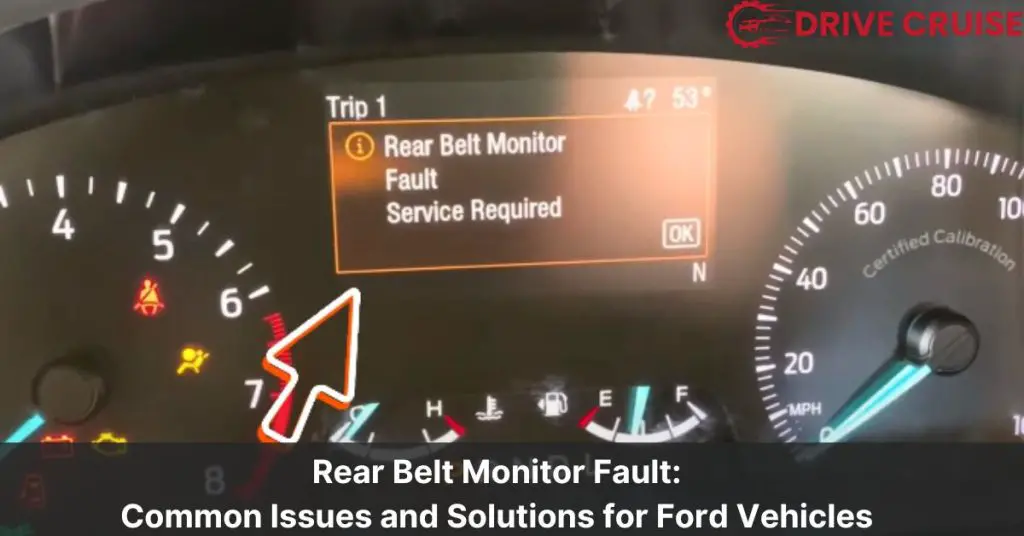We’ve all been there – enjoying a smooth ride in our Ford when suddenly, a warning light decides to make an uninvited appearance. This time, it’s the rear belt monitor fault light, a little reminder that not all is perfect in the realm of automotive harmony. But don’t worry, we’re here to dive into what this means and how we can tackle it together.
Understanding the ins and outs of your vehicle’s safety features is crucial, and the rear belt monitor is no exception. It’s designed to keep us informed and our passengers safe, but when it malfunctions, it can leave us scratching our heads. Let’s embark on a journey to uncover the mystery behind the rear belt monitor fault in Ford vehicles, ensuring we’re all well-equipped to deal with this pesky issue.
Understanding Rear Belt Monitor Fault in Ford Vehicles
Moving forward from recognizing the significance of vehicle safety features, we dive into understanding the rear belt monitor fault in Ford vehicles more deeply. This fault indication, a critical component of the vehicle’s safety system, monitors the status of the rear seat belts to ensure all passengers are properly secured during a journey. When the system detects an inconsistency, such as a belt that isn’t fastened when the vehicle is in motion, it triggers a warning light on the dashboard.
The rear belt monitor system uses sensors to detect the status of seatbelts in the rear seats. These sensors provide real-time data, and any malfunction in the system could lead to false warnings or, conversely, fail to alert when a seatbelt isn’t fastened. It’s essential to address this issue promptly not only to maintain the vehicle’s safety integrity but also to ensure compliance with road safety regulations.
Several factors can trigger a rear belt monitor fault in Ford vehicles, including:
- Sensor Malfunction: If the sensors that detect whether the seat belts are fastened malfunction, the system may incorrectly indicate a fault.
- Wiring Issues: Damage or wear in the wiring connecting the sensors to the vehicle’s computer system can interrupt signal transmission, leading to fault warnings.
- Software Glitches: Sometimes, the vehicle’s onboard computer software may have glitches, causing erroneous warnings.
Addressing these faults requires diagnostic tests that can identify the specific reason behind the warning light. Often, a visit to a certified technician or Ford dealership is necessary to ensure that any issues are correctly diagnosed and resolved. They have the tools and expertise to reset the system, repair any damaged components, or update the vehicle’s software to rectify the fault, restoring the efficacy of this crucial safety feature.
Understanding these aspects emphasizes how vital it is to pay attention to any signs of fault in the rear belt monitor system and take immediate action to rectify them, ensuring passengers’ safety and compliance with safety standards.
Causes of Rear Belt Monitor Faults
Understanding the root causes of rear belt monitor faults in Ford vehicles plays a crucial role in ensuring passenger safety and maintaining the system’s integrity. These faults usually stem from a few common issues that disrupt the normal functioning of the rear belt monitoring system. Below, we’ll explore the primary factors that lead to these faults.
Sensor Malfunctions
Sensors are the eyes of the rear belt monitoring system, constantly checking whether seat belts are fastened in the rear seats. When these sensors fail, they can mistakenly report that a seat belt is unbuckled, even when it’s securely fastened. Causes for sensor malfunctions include wear and tear over time, exposure to liquids, or damage from cargo or passengers.
Wiring Problems
Wires connect the sensors to the vehicle’s computer system, transmitting vital information about seat belt status. Faults in the wiring, such as frays, cuts, or loose connections, can interrupt this communication. Environmental factors like moisture or extreme temperatures, along with physical damage, often lie at the heart of wiring issues.
Software Glitches
The vehicle’s onboard computer processes the information from sensors to alert drivers about unbuckled seat belts. However, software glitches can result in false warnings or failure to recognize when belts are fastened. These glitches might be due to outdated software, errors in the system’s programming, or conflicts resulting from aftermarket modifications.
Physical Obstructions
Sometimes, objects lodged in the seat belt buckle can prevent it from latching correctly, leading to false alerts from the monitoring system. Additionally, extreme dirt or debris accumulation might interfere with sensor detection, misleading the system into thinking a seat belt is unbuckled.
By identifying these causes, owners can better understand the steps needed for troubleshooting and repair, emphasizing the importance of addressing rear belt monitor faults promptly to ensure the safety of all passengers.
Diagnosing Rear Belt Monitor Faults in Ford Vehicles
After understanding the common causes behind rear belt monitor faults in Ford vehicles, ranging from sensor malfunctions to wiring problems and software issues, we shift our focus to diagnosing these faults effectively. This process is crucial to identifying the specific issue at hand and ensuring a timely and appropriate repair solution. Here’s how we approach this diagnostic process.
First, we perform a visual inspection of the seat belt components, checking for any physical obstructions or visible damage to the seat belt system. Objects lodged in the buckle or visible wear and tear can give us immediate clues about the problem.
Next, we check the vehicle’s diagnostic system for error codes, often using a professional-grade scanner. Ford vehicles equipped with advanced onboard diagnostics (OBD) systems will store fault codes that can pinpoint issues with the rear belt monitor system. These codes guide us to the root cause, whether it’s a sensor malfunction, wiring issue, or a software glitch.
We also test the wiring and connections leading to the rear belt monitor system. Using a multimeter, we check for continuity, ensuring the wiring hasn’t been compromised and that electrical connections are secure and functioning as intended.
Software issues require a different approach. We update or reflash the vehicle’s onboard software, as updates may include fixes for known bugs affecting the rear belt monitor system. This step often requires specialized equipment and software provided by Ford or certified third parties.
Lastly, if the seat belt monitor warning persists despite no visible issues or after clearing any error codes, we perform a more in-depth examination. This might involve checking the seat belt pretensioners and sensors for hidden faults that aren’t immediately obvious.
Throughout this diagnostic process, we keep safety and accuracy at the forefront, using only certified techniques and tools to ensure your Ford’s rear belt monitor system is functioning correctly and reliably. By tackling each potential cause systematically, we can identify and resolve issues with precision, returning your vehicle to its optimal safety standards.
How to Fix Rear Belt Monitor Faults
After understanding the importance of addressing rear belt monitor faults in Ford vehicles, let’s explore the steps to fix these issues. Our goal is to ensure that the rear belt monitor system operates reliably, enhancing passenger safety.
Conduct a Thorough Visual Inspection
Initially, we suggest visually inspecting the seat belts and their components. Look for any signs of wear and tear, and ensure there’s no physical obstruction that might influence the system’s functionality. Removing any objects stuck in the buckles is a good starting point.
Check Wiring and Connections
Next, examining the wiring and connections related to the rear belt monitor system is critical. Loose or corroded connections can lead to false alerts. Tighten any loose connections and clean corrosion from terminals to restore proper communication.
Utilize Diagnostic Tools
Using diagnostic tools to read error codes from the vehicle’s computer can offer insights into what’s causing the monitor fault. Codes specifically related to the seat belt system can guide us towards the issue, whether it’s a sensor malfunction or a software glitch.
Update Software
Sometimes, the root of the problem is outdated software that needs an update. Check for any available updates for your vehicle’s system and install them. This step often solves software-related issues that might cause the rear belt monitor to malfunction.
Seek Professional Help
If the fault persists after these steps, it may signify a more complex problem that requires professional attention. Taking your Ford to a certified technician ensures a thorough examination and repair. Professionals have the tools and expertise to diagnose accurately and fix the issue, ensuring the system works as intended.
By following these steps, we can tackle rear belt monitor faults effectively. Starting from a simple visual check to potentially requiring professional intervention, each step plays a crucial role in maintaining the safety and reliability of Ford vehicles.
Preventing Future Rear Belt Monitor Faults
After diving into the intricate process of diagnosing and fixing rear belt monitor faults in Ford vehicles, we now turn our focus to prevention. Ensuring these systems work flawlessly not only keeps passengers safe but also saves time and resources in the long run. Here are practical steps to minimize the risk of future rear belt monitor faults in Ford vehicles:
- Regular Maintenance Checks: Incorporate the rear belt monitor system into your routine vehicle maintenance schedule. Regular checks help catch potential issues early, before they escalate.
- Software Updates: Stay informed about the latest software updates from Ford. Manufacturers often release patches or new versions of software to address known bugs, including those that may affect the rear belt monitor system.
- Professional Inspections: If you’re not entirely comfortable checking the system yourself, don’t hesitate to seek professional assistance. Technicians with experience in Ford vehicles can offer comprehensive inspections and advice.
- Use Genuine Parts: In the event of necessary repairs or replacements, opt for genuine Ford parts or those recommended by the manufacturer. This ensures compatibility and reliability, significantly reducing the risk of faults due to substandard components.
- Educate Passengers: Sometimes, the way passengers use seat belts can inadvertently trigger monitor alerts. Educating them on the correct use of seat belts and the importance of the monitoring system can prevent misuse and reduce false alerts.
By integrating these preventative measures, we can significantly reduce the likelihood of encountering rear belt monitor faults. Keeping up with maintenance, staying updated on software, and using genuine parts are key practices that help maintain the system’s integrity. Moreover, occasional professional assessments and educating users play a crucial role in the system’s long-term functionality, ensuring our Ford vehicles remain safe and reliable for every journey.
Conclusion
We’ve navigated through the intricate details of addressing and preventing rear belt monitor faults in Ford vehicles. It’s clear that keeping passengers safe goes beyond just fixing issues as they arise. By integrating these systems into our routine maintenance and staying informed about the latest software updates, we’re taking proactive steps towards ensuring our vehicles remain safe for everyone on board. Let’s not forget the importance of using genuine parts and educating our passengers on the correct use of seat belts. Together, we can keep our journeys safe and our minds at ease knowing we’ve done everything to prevent rear belt monitor faults.
Related Posts:
- Adaptive Cruise Control Unavailable: What to Do When Your Car’s ACC System Fails
- Best Tonneau Cover for Ford Maverick: Top Picks and Reviews
- Engine Coolant Over Temperature on Ford: Causes and Solutions
- Ford 5.4 Coolant Temp Sensor Location: A Quick Guide
- Full Accessory Power Active: How to Maximize Your Car’s Electrical System
- Park Assist Blocked: How to Troubleshoot the Issue
- Power Steering Assist Fault on Ford Fusion: Causes and Solutions
- Rear Belt Monitor Fault: Common Issues and Solutions for Ford Vehicles







